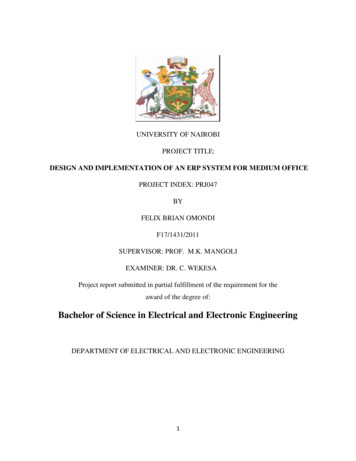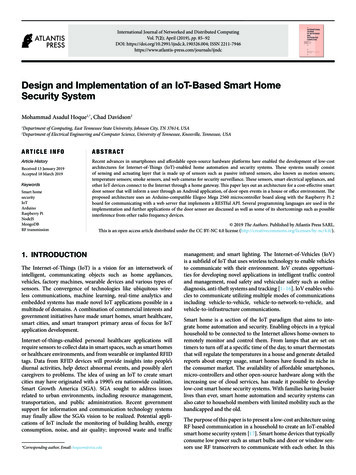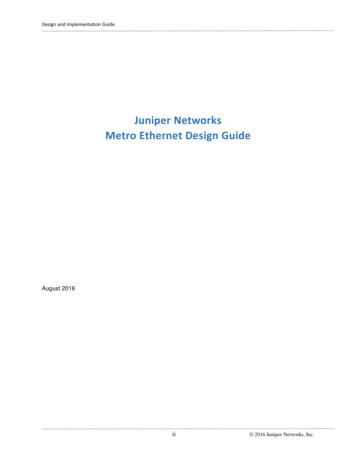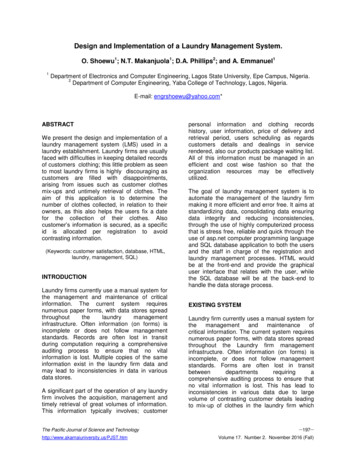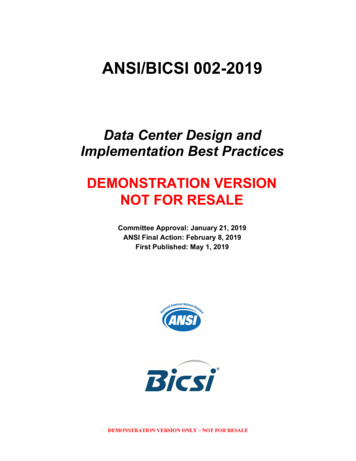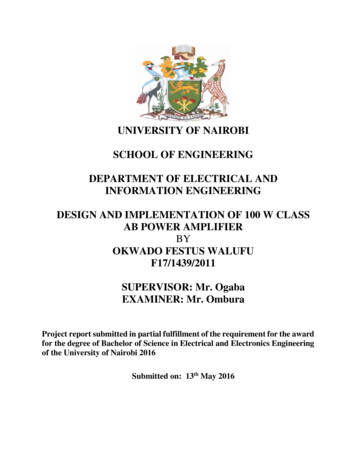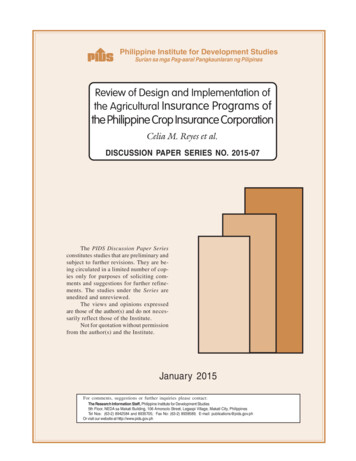
Transcription
Philippine Institute for Development StudiesSurian sa mga Pag-aaral Pangkaunlaran ng PilipinasReview of Design and Implementation ofthe Agricultural Insurance Programs ofthe Philippine Crop Insurance CorporationCelia M. Reyes et al.DISCUSSION PAPER SERIES NO. 2015-07The PIDS Discussion Paper Seriesconstitutes studies that are preliminary andsubject to further revisions. They are being circulated in a limited number of copies only for purposes of soliciting comments and suggestions for further refinements. The studies under the Series areunedited and unreviewed.The views and opinions expressedare those of the author(s) and do not necessarily reflect those of the Institute.Not for quotation without permissionfrom the author(s) and the Institute.January 2015For comments, suggestions or further inquiries please contact:The Research Information Staff, Philippine Institute for Development Studies5th Floor, NEDA sa Makati Building, 106 Amorsolo Street, Legaspi Village, Makati City, PhilippinesTel Nos: (63-2) 8942584 and 8935705; Fax No: (63-2) 8939589; E-mail: publications@pids.gov.phOr visit our website at http://www.pids.gov.ph
Draft/01/13/2015Review of design and implementation of the agricultural insurance programsof the Philippine Crop Insurance Corporation (PCIC)AbstractThe situation of the poor who participate in the country's agricultural sector has been exacerbatedby the increasingly prevalent natural calamities, pests, and other such unpredictable event.However, there are certain risk management tools that aid in lessening the farmers' financialburden when losses related to such natural disasters are incurred. One of them is the crop oragricultural insurance. In the Philippines, the Philippine Crop Insurance Corporation (PCIC) isthe government organization that implements rice, corn, high-value commercial crop, livestock,non-crop agricultural asset, fishery, and term insurance programs. The question thus arisesregarding the effectiveness and sustainability of the said programs. It is thus the purpose of thisstudy toreview the design and implementation of the PCIC’s insurance programs. Key informantinterviews and focus group discussions with various PCIC clients and partners in selectedregions of the country, together with desktop review and secondary data analysis, wereconducted.Keywords: Philippine Crop Insurance Corporation, agricultural insurance, design,implementation, process evaluation1
Review of design and implementation of the agricultural insurance programsof the Philippine Crop Insurance Corporation (PCIC)Celia M. Reyes, Christian D. Mina, Reneli Ann B. Gloria, and Sarah Joy P. Mercado 11. IntroductionThe contribution of the agriculture sector in economic development cannot be undervalued.Through the years, it has remained as an important source of food, vital raw materials andemployment to the Philippine economy (Habito and Briones, 2005). While this is true, growth inthis sector has remained stagnant. Growth in gross value-added (GVA) in agriculture has beenerratic and has remained below 5 percent for the past decade. This slow growth in agriculturaloutput can explain why the sector has only absorbed around 11-12 million workers and its shareto total employment has been slowly dwindling from roughly 40 percent to less than a third(PSA, 2014; ADB, 2014). This is a major concern because the agriculture sector absorbs asignificant proportion of the working poor, particularly in rural areas (Reyes and Mina, 2013;Hasan and Jandoc, 2009). High poverty rates are exhibited across the different agriculturalsubsectors, particularly growing of coconut, coffee, cacao, and sugarcane. Interestingly, 42percent of the transient poor are found to be engaged in agriculture (Reyes et al., 2011).Venturing into the agricultural sector, particularly in crop production, entails certain risks. Onebad harvest for farmers would translate to substantial losses since these farmers may not be ableto recover their investments (Magno and Bautista, 1989). This is not surprising given thatagriculture is very much dependent on weather. With the effects of climate change beingmanifested through increased frequency and intensity of typhoons and other extreme weatherevents, risks for farmers might be greater. One mechanism for managing risk is the agriculturalinsurance. This agricultural insurance can be an effective safety net that would enableagricultural producers, particularly the transient poor or those who are moving in and out ofpoverty, to recover more quickly from the shock. In contrast to some on-farm strategies thatcontribute to production losses, crop insurance allows mitigation from “high-severity, lowfrequency correlated risks” (Bangsal and Mamhot, 2012).In the Philippines, the Philippine Crop Insurance Corporation (PCIC) is the governmentorganization that implements rice, corn, high-value commercial crop, livestock, non-cropagricultural asset, fishery, and term insurance programs. The question thus arises regarding theeffectiveness and sustainability of the said programs. This report is first in a series of papers forthe project that aims to evaluate the agricultural insurance programs of the Philippine CropInsurance Corporation (PCIC). Also known as the process evaluation report, this paper reviewsthe design and implementation of the PCIC’s insurance programs.1Celia M. Reyes is Senior Research Fellow; Christian D. Mina and Reneli Ann B. Gloria are Supervising ResearchSpecialists; and, Sarah Joy P. Mercado is Research Analyst II at the Philippine Institute for Development Studies.The authors gratefully acknowledge the following: Ronina D. Asis and Maria Blesila D. Mondez, for providingexcellent research assistance; officials and technical staff of the PCIC (both from main and regional offices), forproviding all the information and data used herein. The usual disclaimer applies.2
2. Review of assessments conductedThere have only been a handful of studies that assessed the agricultural insurance programs ofthe PCIC. Among the most noted issues are related to the financial sustainability andimplementation of the PCIC’s insurance programs. Bangsal and Mamhot (2012) argued that theimplementation of a crop insurance scheme is usually associated with asymmetric informationbetween a farmer and an insurer, thus resulting in high transaction costs. The marketing,operational and other administrative costs of the PCIC were found to be higher than the amountof premiums collected. Similar set of bottlenecks was identified by other studies, i.e., Corpuz(2013), Reyes and Domingo (2009), and Estacio and Mordeno (2001). In addition, operations ofthe PCIC have been impeded by the lack of funding. Corpuz (2013) specifically mentioned thatthe agricultural insurance programs receive insufficient amount of subsidies and lowcapitalization from the government. Bangsal and Mamhot (2012) pointed out that government’sequity shares were not being paid in full. Reyes and Domingo (2009) noted that remittances fromthe government have been delayed, which resulted in poor government capital contribution. Afew studies argued that agricultural insurance programs have been largely ran by governmentsubsidies and thus, might not be sustainable (Bangsal and Mamhot, 2012; Reyes and Domingo,2009). Corpuz (2013) mentioned that have it not been for subsidies, farmers could have notafforded the high premium rates of rice and corn insurance policies.Earlier studies alsoraised the issue of low penetration rate (e.g., Bangsal and Mamhot, 2012).Lack of awareness was found by Rola and Aragon (2013) as the primary reason for minimalparticipation in agricultural insurance programs of rice farmers in selected communities inLaguna. In fact, these selected rice farmers admitted that they only participated in the riceinsurance program mainly because rice insurance was a requirement for obtaining a loan fromthe Land Bank of the Philippines (LBP). Reyes and Domingo (2009) found that crop insurancewas virtually non-existent in select farming communities because formal lending institutions arenot present in those areas. Apparently, the main clientele of the PCIC are the borrowing farmersbut only a small proportion of farmers have access to loans provided by formal lendinginstitutions. Another implementation issue is the determination of compensation for damagedcrops. Corpuz (2013), in particular, argued that the claims validation and other related operationsof the PCIC are not efficient.A different perspective can be gleaned from Magno and Bautista (1989), which assessed theeffectiveness and efficiency of the crop insurance program as well as the government’s role inprogram implementation. Based on the assessment, crop insurance could be more effective as apartial collateral substitute and as a relief measure but not as a risk mitigation tool. The studyalso noted that crop insurance didnot result in increased technological adoption and thus,increased production.3. MethodologyIn order to answer the objectives of the study, primary and secondary data analyses were carriedout. Desktop review of past assessment studies and other relevant documents containing3
information on the insurance programs was done. Secondary data from the PCIC main andregional offices and other stakeholders were also analyzed.In addition, key informant interviews (KIIs) and focus group discussions (FGDs) were alsoconducted to corroborate the findings from the desktop review and secondary data analysis. Theteam conducted various KIIs with national government agencies such as PCIC main office, LandBank of the Philippines (LBP), Department of Agriculture (DA), Department of AgrarianReform (DAR), and Department of Budget and Management (DBM). The team also visitedselected regions like Regions II (Cagayan), VI (Negros Occidental), VII (Cebu and NegrosOriental), and XI (Davao del Norte) to conduct KIIs with PCIC and DAR regional offices, LBPprovincial lending centers and Rural Bankers’ Association of the Philippines (RBAP)representatives.FGDs with various PCIC clients, partners and even with agricultural producerswithout agricultural insurance were also conducted.4. Overview of the agricultural insurance programs in the Philippines4.1. The Philippine Crop Insurance Corporation (PCIC)In order to understand the rationale for the creation of the PCIC and its ties with the history ofthe provision of agricultural credit, a short backgrounder on agrarian reform is quite necessary.The first landmark legislation providing for a mechanism to extend credit and similar assistanceto agriculture, including marketing and technical services, was related to the institution of landreform in the Philippines. Republic Act (R.A.) 3844, which was signed into law by PresidentDiosdado Macapagal on August 8, 1963, also provided for an institution to finance theacquisition and distribution of agricultural land, thereby creating the LBP.In order to accelerate the implementation of R.A. 3844, President Ferdinand Marcos signed R.A.6390 into law on September 10, 1971, created an Agrarian Reform Special Account amountingto PhP50 million. The utilization of this PhP50 million, as mandated by law, is as follows: PhP20million for additional credit for agricultural lending; PhP20 million used as the government’scapital contribution to the LBP; and, the remaining PhP10 million for land development andresettlement. This law also created the Agriculture Guarantee Fund (AGF) that would shoulder70 percent of losses to rural banks due to loans extended under the supervised agricultural creditprogram 2 . The PhP20 million (from the funds accruing from the Agrarian Reform SpecialAccount after June 1972) was earmarked for the use of the AGF.Despite the funds allocated for the LBP (the only financial institution established for agrarianreform), it was found to be deficient in supporting the implementation of land reform. Thus,2As a requirement for rural banks to avail of the Agriculture Guarantee Fund, they should extend loans under thefollowing conditions: (1) the farmer must agree in writing that s/he will apply approved farm practices under asupervised credit program; (2) the farm plan and budget shall be the basis of the loan; (3) the farmer-borrowershall not be tilling more than six hectares; (4) priority must be given to cooperatives, farmers with leaseholdcontracts, or a member of a cooperative or an agrarian reform beneficiary (ARB); (5) acceptable collateral is any ora combination of real estate (if available), chattel mortgage on standing crops/livestock, stored crops in bondedwarehouses, or two co-makers acceptable to the bank.4
Presidential Decree (P.D.) No. 251, which was issued on July 21, 1973, increased the capitalstock of the Bank to PhP3 billion, required government agencies to make the LBP the officialdepository, and expanded the mandate of the LBP to include granting of loans to farmers’cooperatives/associations for agricultural production purposes. As further support to agrarianreform credit, P.D. No. 717 was enacted on May 29, 1975, requiring government and privatelending institutions to allocate 25 percent of their loanable funds to agricultural credit in general,of which at least 10 percent shall be allocated to agrarian reform credit.The PCIC, created by virtue of P.D. No. 1467 on June 11, 1978, was financed via the AGF,which was transferred to the new Corporation as part of the government’s contribution to thecapital of PCIC. This AGF was previously administered by the LBP and used to guarantee therice production loans under the supervised credit program of the LBP. As provided for in Section7 of P.D. No. 1467, it was up to the Board of Directors of the new Corporation if they wanted tocontinue the guarantee operations commenced using the AGF3. Thus, the real provenance of thePCIC came from funds earmarked for agrarian reform credit, making the PCIC an institutionalprogeny of land reform. The LBP initiated the creation of an inter-agency committee that carriedout a study on the feasibility of implementing crop insurance, and initially envisioned cropinsurance as part of their supervised credit programs. The committee—the Inter-AgencyCommittee for the Development of the Philippine Crop Insurance System (IAC-PCIS)—comprised representatives from the DA, DAR, Armed Forces of the Philippines (AFP), privateinsurance industry, other private agencies, cooperative organizations, and the University of thePhilippines (U.P.).In order to make the PCIC more responsive, its charter was amended by P.D. No. 1733 onOctober 21, 1980 and further amended by R.A. 8175 on December 29, 1995. P.D. No. 1733,proclaimed on October 21, 1980, made crop insurance compulsory for all lending institutionsgranting production loans for palay under the supervised credit programs4 of the government,and the same shall act as underwriters for the PCIC. Any person or institution implementing agovernment supervised credit program without requiring crop insurance will be fined PhP10,000.The PCIC was also mandated by President Marcos, via Letter of Instruction No. 1242 toadminister a Trust Fund5 amounting to PhP450 million (to be given in tranches for a period of 3years) as payment for claims of the Philippine National Bank and the rural banks thatparticipated in the Masagana 99 credit program6, to the extent of 85 percent good credit standingof these banks with the Bangko Sentral ng Pilipinas and enable them to be capable of offering3This was implemented during the days of Masagana 99 and the directed credit programs, but stopped after theAFMA directive.4Supervised credit program, as used in the Decree, is defined as a production credit program wherein the farmeragrees in writing to apply proven farm practices and abide by the farm plan and budget prepared by him and theaccredited supervised credit technician.5Also known as the Special Revolving Trust Fund (SRTF). Based on the 2013 Annual Audit Report for the PCIC bythe Commission on Audit, about P301.979 million is unutilized as of 31 December 2013, and is currently placed in aHigh Yield Savings Account at the Land Bank of the Philippines.6Farm credit on a non-collateral basis, fertilizer subsidy and extension services are the main components of theMasagana 99 program. It was conceived and launched on May 21, 1973 out of the need to massively increase riceproduction, after a series of farm crop failures in 1971-73, given the country’s heavy dependence on rice importsand a world grain crisis during that time.5
financial services to the rural communities under the supervised credit program. Thus,historically, crop or agricultural insurance of the PCIC was utilized by the government mainly asan agricultural support mechanism to expand agricultural credit, where agricultural credit as themain risk management tool used by farmers in case of shocks.The PCIC has been mandated to provide insurance protection to agricultural producers in thePhilippines against losses of crops and non-crop agricultural assets due to natural calamities,pests and diseases, and other perils (PCIC, 2014). It implements and manages variousagricultural insurance programs of the government. Under the auspices of the DA, thePCICoperates as a government-owned and controlled corporation and its administrativeoperations are not funded by the national government. Its operation has also been decentralizedup to the regional level. The PCIC have 13 regional offices (RO’s) operating nationwide.However, not all regions (based on the official classification used by the Philippine StatisticalAuthority (PSA)) have existing PCIC-RO. Some of these RO’s cover more than one region(Figure 1). For instance, the provinces in Cordillera Administrative Region (CAR) were dividedinto two; one set of which (western part: Abra, Benguet and Mountain Province) falls underRegion I while the other set (eastern part: Apayao, Ifugao and Kalinga) is covered by Region II.Because PCIC is not operating in each region and the RO’s may not be accessible to manyagricultural producers, the PCIC put up a number of provincial extension offices (Table 1). ThePCIC has 14 plantilla positions for each R.O., plus a number of job orders (depending on thevolume of work and/or season).(a) using official regional classificationFigure 1. PCIC Regional Offices(b) using PCIC’s regional classification6
Table 1. Provincial extension offices of the PCIC, as of December 2014Regional OfficeIIIIIIIII-AIVVVIVIIVIIIIXXXIXIIProvincial Extension OfficeBontoc, Mt. ProvinceBangued, AbraOffice of the Provincial Agriculturist, Bulanao, Tabuk City,KalingaNIA Office, Libertad, Abulug, CagayanOffice of the Provincial Agriculturist, Lagawe, IfugaoNIA Office, Batal, Santiago City, IsabelaNIA Centro, San Manuel, IsabelaOffice of the Provincial Agriculturist, Bayombong, NuevaEcijaNIA Office, Bulala, Camalaniugan, Cagayan2nd Floor, Aurora Bank Bldg., Baler, AuroraOdyongan, RomblonCagba, Tugbo, Masbate CityEcopark, Upper Turno, Dipolog CityButuan CityDFFC Bldg. Rabe Subd., Tagum CityDa-Lebak, Poblacion II, Lebak, Sultan KudaratDateoperationalizedApril 1, 2014June 2, 2014February 24, 2014April 3, 2014May 19, 2014July 1, 2014July 3, 2014August 15, 2014August 26, 2014January 13, 2015April, 2014May 15, 2014April 7, 2014June 3, 2014April 21, 2014Source: PCIC4.2. Features of the agricultural insurance programs4.2.1. ObjectivesCrop insurance is defined as a financial instrument used to manage agricultural production riskscaused by natural calamities, pest infestation, and plant diseases, among others. It is designed toprotect the farmers against financial losses by transferring agricultural risks to a third party. It isa “risk-pooling instrument” that involves collection of premia and “assessment and payment ofindemnity claims7 for all or part of financial losses” (Bangsal and Mamhot, 2012, p. 3). Cropinsurance is also used to encourage risk-averse farmers to engage in riskier and more profitableactiviti
Insurance Corporation (PCIC). Also known as the process evaluation report, this paper reviews the design and implementation of the PCIC’s insurance programs. 1 Celia M. Reyes is Senior Research Fellow; Christian D. Mina and Reneli Ann B. Gloria are Supervising Research


